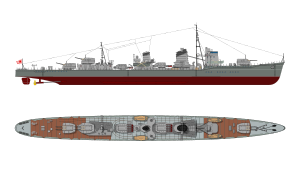Japanese destroyer Ōnami (1942)
 Right elevation and plan of a Yūgumo-class destroyer | |
| History | |
|---|---|
| Name | Ōnami |
| Builder | Fujinagata Shipbuilding Yard |
| Laid down | 15 November 1941 |
| Launched | 31 August 1942 |
| Completed | 29 December 1942 |
| Commissioned | 20 January 1943, 31st Destroyer Division |
| Stricken | 10 February 1944 |
| Fate | Sunk in action, 25 November 1943 |
| General characteristics | |
| Class and type | Yūgumo-class destroyer |
| Displacement | |
| Length | 119.15 m (390 ft 11 in) |
| Beam | 10.8 m (35 ft 5 in) |
| Draught | 3.75 m (12 ft 4 in) |
| Speed | 35 knots (40 mph; 65 km/h) |
| Complement | 228 |
| Armament |
|
Ōnami (大波) was a Yūgumo-class destroyer of the Imperial Japanese Navy. Her name means "Billow Wave" (Big Rough Waves).
Design and description[edit]
The Yūgumo class was a repeat of the preceding Kagerō class with minor improvements that increased their anti-aircraft capabilities. Their crew numbered 228 officers and enlisted men. The ships measured 119.17 meters (391 ft 0 in) overall, with a beam of 10.8 meters (35 ft 5 in) and a draft of 3.76 meters (12 ft 4 in).[1] They displaced 2,110 metric tons (2,080 long tons) at standard load and 2,560 metric tons (2,520 long tons) at deep load.[2] The ships had two Kampon geared steam turbines, each driving one propeller shaft, using steam provided by three Kampon water-tube boilers. The turbines were rated at a total of 52,000 shaft horsepower (39,000 kW) for a designed speed of 35 knots (65 km/h; 40 mph).[3]
The main armament of the Yūgumo class consisted of six Type 3 127-millimeter (5.0 in) guns in three twin-gun turrets, one superfiring pair aft and one turret forward of the superstructure.[2] The guns were able to elevate up to 75° to increase their ability against aircraft, but their slow rate of fire, slow traversing speed, and the lack of any sort of high-angle fire-control system meant that they were virtually useless as anti-aircraft guns.[4] They were built with four Type 96 25-millimeter (1.0 in) anti-aircraft guns in two twin-gun mounts, but more of these guns were added over the course of the war. The ships were also armed with eight 610-millimeter (24.0 in) torpedo tubes in a two quadruple traversing mounts; one reload was carried for each tube. Their anti-submarine weapons comprised two depth charge throwers for which 36 depth charges were carried.[2]
Construction and career[edit]
On the night of 24–25 November 1943, Ōnami led a troop transport/evacuation run to Buka Island. In the Battle of Cape St. George, she was torpedoed by the destroyers USS Charles Ausburne, Claxton and/or Dyson, 55 miles (89 km) east-southeast of Cape St. George (05°15′S 153°49′E / 5.250°S 153.817°E). Ōnami blew up and sank with all hands, including ComDesDiv 31 (Captain Kiyoto Kagawa).[5] Captain Kiyoto Kagawa was posthumously promoted two ranks, one of the few IJN destroyer skippers so honored.
Notes[edit]
References[edit]
- Campbell, John (1985). Naval Weapons of World War II. Annapolis, Maryland: Naval Institute Press. ISBN 0-87021-459-4.
- Jentschura, Hansgeorg; Jung, Dieter & Mickel, Peter (1977). Warships of the Imperial Japanese Navy, 1869–1945. Annapolis, Maryland: United States Naval Institute. ISBN 0-87021-893-X.
- Sturton, Ian (1980). "Japan". In Chesneau, Roger (ed.). Conway's All the World's Fighting Ships 1922–1946. Greenwich, UK: Conway Maritime Press. pp. 167–217. ISBN 0-85177-146-7.
- Whitley, M. J. (2000). Destroyers of World War Two: An International Encyclopedia. London: Cassell & Co. ISBN 1-85409-521-8.


 French
French Deutsch
Deutsch